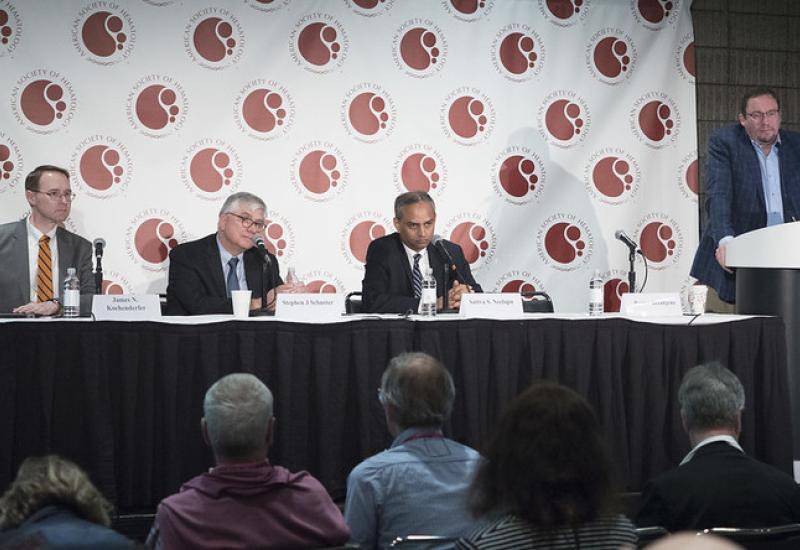
ESMO 2025 preview – first clinical results
The ESMO regular abstract lift reveals first human datasets for several projects.
The ESMO regular abstract lift reveals first human datasets for several projects.

Lilly's FGFR3 inhibitor vepugratinib and HengRui's KRAS G12C inhibitor HRS-7058 have stood out among biopharma projects for which the first ever human data have just been revealed in upcoming regular presentations at ESMO. Both have delivered impressive-looking clinical activity in their respective settings, at least according to their now public ESMO abstracts.
As for one of the conference's most eagerly awaited early datasets, covering Moderna's mRNA-4359, the results are extremely early, but they hint at a surprising cross-trial advantage for IO Biotech's ill-fated Cylembio. And the first-in-human wooden spoon will surely go to Novartis's HRO761, which looks like another Werner helicase inhibitor headed for the scrapheap.
Hopes surely couldn't have been high for HRO761, given that Novartis still hadn't revealed any data since entering phase 1 two years ago. The project is now revealed to have delivered response rates in the region of 10%, meaning that it's likely to head the same way as RO7589831, the Werner helicase inhibitor Roche handed back to Bayer in June.
Pleasant surprise
But for HengRui the data covering its KRAS G12C inhibitor HRS-7058 have come as a pleasant surprise after the disappointment of the G12D asset HRS-4642, whose 6% ORR was a big letdown at ESMO 2023.
What stands out especially regarding the new project is its activity in patients who had already been treated with another KRAS G12C inhibitor. The abstract reveals an impressive 23% response rate among 19 such patients with NSCLC; meanwhile, in 42 KRAS G12C inhibitor-naive NSCLC subjects the ORR is 61%.
And Lilly is working on a possible rival to Johnson & Johnson's approved FGFR1/2/3/4 inhibitor Balversa, claiming that vepugratinib is a highly isoform-selective FGFR3 inhibitor. Its ESMO abstracts reveals a 29% response rate, including three responses among seven Balversa-pretreated patients; one curiosity is that subjects treated with a relatively low dose appear to be doing better than all-comers.
Selected first-in-human data from ESMO regular presentations
| Project/setting | Mechanism | Company | Data | Abstract |
|---|---|---|---|---|
| HRS-7058 in KRAS G12Cm solid tumours | KRAS G12C inhibitor | Jiangsu HengRui | ORR 48% in KRAS G12Ci-naive NSCLC (n=42); ORR 23% in KRAS G12Ci-pretreated NSCLC (n=19) | 914O |
| INCB161734 in solid tumours | KRAS G12D inhibitor | Incyte | ORR 30% (n=27) at doses ≥600mg daily | 916O |
| DS-3939 in solid tumours | TA-MUC1 ADC | Daiichi Sankyo | ORR 26% (n=38) at dose levels 2-6 | 917O |
| SNV1521 in solid tumours | Parp1 inhibitor | Synnovation Therapeutics | ORR 10% in canonical tumours (n=20); ORR 8% in non-canonical tumours (n=12) | 923MO |
| ART6043 +/-Lynparza in solid tumours | DNA polymerase θ inhibitor | Artios | N=19 monorx, n=42 Lynparza combo, but no data in abstract | 924MO |
| HRO761 in MSI-H/dMMR solid tumours | WRN inhibitor | Novartis | ORR 11% in colorectal (n=19), 6% in non-colorectal (n=16); all ORR 9% (n=35) | 925MO |
| mRNA-4359 + Keytruda in CI-refractory melanoma | PD-L1/IDO immunotherapy | Moderna | ORR 67% in PD-L1≥1% (n=9), 0% in PD-L1<1% (n=13) | 1515MO |
| BI 1703880 + ezabenlimab in solid tumours | Sting agonist | Boehringer Ingelheim | ORR 9% (n=34), unclear if in combo; one patient experienced Gr3 increased ALT | 1519MO |
| INCA33890 in relapsed solid tumours | PD-1 x TGFβR2 MAb | Incyte | ORR 12% in MSS-colorectal (n=97); other responses seen, including 2 (in NSCLC, head & neck) after prior anti-PD-1 | 1522MO |
| FOG-001 in desmoid tumours | β-catenin:TCF4 inhibitor | Parabilis Medicines | ORR 50% (n=4), incl in 1 patient who had progressed on Ogsiveo | 2688MO |
| Vepugratinib in FGFR3+ve urothelial cancer | FGFR3 inhibitor | Lilly | ORR 29% for ≥200mg BID (n=82; plus 7 uPR pending); ORR 39% for 200mg BID (n=28), including 43% in FGFRi pretreated (n=7) | 3070MO |
Note: data cutoffs between Dec 2024 and Apr 2025. Source: ESMO.
When ESMO presentation titles went live they revealed that IO Biotech had scored a late-breaker for its IDO/PD-L1 peptide immunotherapy Cylembio, but the victory was tainted by news that the FDA had told the company it couldn't file the melanoma data for approval.
Now the regular abstracts have revealed the first data for a key competitor, Moderna's mRNA-4359, which is also an IDO/PD-L1 immunotherapy, though these peptides are encoded by mRNA. Cylembio and mRNA-4359 are both given alongside Keytruda but, while IO Biotech's study concerned a first-line setting, Moderna's ESMO data are in a checkpoint inhibitor-resistant/refractory population.
Moderna's ESMO abstract reveals promising activity in PD-L1-expressers, but zero responses among 13 patients with PD-L1 levels below 1%. Notwithstanding the different melanoma settings, this is starkly at odds with the data for Cylembio, which was said to have shown "a profound effect" in PD-L1-negative tumours, yielding median PFS of 16.6 months versus 3.0 months for Keytruda control.
Among other regular first-in-human ESMO abstracts, it's also fair to say that Daiichi Sankyo's anti-TA-MUC1 ADC DS-3939, Incyte's anti-PD-1 x TGFβR2 MAb INCA33890 and Parabilis's β-catenin:TCF4 inhibitor FOG-001 look intriguing, but their datasets are too early, or the abstract disclosures too vague, to make an immediate call on the data.
ESMO will take place in Berlin on 17-21 October.
5500













